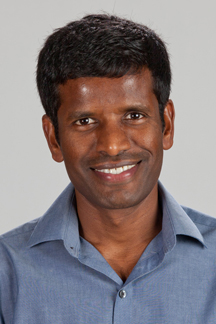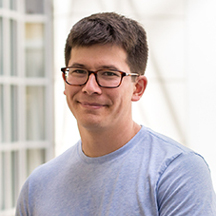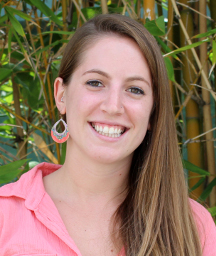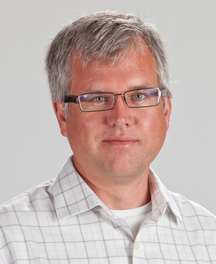In Brief
Srinivasa Subramaniam receives funding to study connection between aging and Huntington’s disease
Researchers on the Florida campus of The Scripps Research Institute have received support from CHDI Foundation, Inc., for research into how Huntington’s disease (HD) progresses. HD is an inherited neurodegenerative disease that robs people of their motor skills and memories, eventually killing them.
Srinivasa Subramaniam, PhD, associate professor at Scripps Research, will lead the new project to investigate why Huntington’s disease targets a region of the brain called the striatum—and why the damage to the striatum occurs later in life, often between ages 30 and 50.
“We don’t understand why the disease comes so late,” says Subramaniam. “So knowing the mechanism behind this activation is important for understanding not only HD but other age-related disorders.”
Previous studies from Subramaniam’s lab provided a strong link between aging and neurodegenerative diseases, including Alzheimer’s and Parkinson’s diseases. With this new funding, Subramaniam and his colleagues aim to better understand the role and the mechanisms of overactivation of mTOR signaling, a pathway involved in aging, in HD, using patient-derived striatal neurons.
CHDI Foundation is a privately-funded nonprofit biomedical research organization dedicated to rapidly developing therapies that substantially improve the lives of individuals affected by HD. The organization works closely with more than 700 researchers around the world in the pursuit of novel therapies for the disease.
Subramaniam says the collaborative environment and state-of-the-art facilities on campus can help researchers pursue promising leads in the HD field. “The scientific expertise at Scripps Florida offers all sorts of great opportunities,” he says.
Keary Engle receives Bayer Early Excellence in Science Award
Chemist Keary M. Engle, PhD, of The Scripps Research Institute, has received the Bayer Early Excellence in Science Award for Chemistry from the Bayer Science & Education Foundation. The award recognizes excellent young scientists and physicians in the early stages of their academic and clinical research careers.
Engle, who is also a Scripps Research alumnus, is focused on advancing the efficiency, effectiveness and sustainability of chemical synthesis. His lab seeks to invent a variety of selective catalytic reactions to functionalization carbon-carbon π-bonds to prepare valuable target motifs.
"It's a tremendous honor to be selected for this distinction, given the impressive accomplishments of previous awardees,” says Engle. “I view it as a direct reflection of the tireless work ethic and boundless creativity of my team of students and postdocs. It's wonderful to see their efforts recognized on an international level."
The prize of EUR 10,000 will be presented in June at the Bayer Foundation Day in Berlin.
Danielle Grotjahn receives Harold M. Weintraub Graduate Student Award
Danielle Grotjahn of the Lander lab has been awarded the 2018 Harold M. Weintraub Graduate Student Award, in recognition of outstanding achievement in graduate studies in the biological sciences. Nominations for this prestigious annual award, presented by the Fred Hutchinson Cancer Center, are solicited internationally.
“My research takes a structural approach to understand fundamental mechanisms by which dynein motor proteins shuttle cellular cargo throughout the dynamic intracellular environment,” says Grotjahn, a fifth-year graduate student at The Scripps Research Institute. “Visualizing the three-dimensional molecular and structural details of this transport complex will build a vital foundation towards understanding how defects in this transport machinery may lead to the progression of neurodegenerative disease.”
“Through her in-depth visualization of the dynein motor complex, Danielle has made a discovery that changes the way we view a fundamental component of cell biology,” says Gabriel Lander, PhD, an associate professor at Scripps Research. “Her hard work sheds new light on decades worth of prior research, and profoundly impacts the way that cellular transport pathways are studied going forward.”
Grotjahn, one of thirteen awardees this year, will be presented with her award on May 4 at a scientific symposium at the Hutch in Seattle.
CA Lunch & Learn: What’s your attachment style?
Join Scripps Research counseling center psychologist Tamera Ho, PhD, on April 24 for a Lunch & Learn titled “What’s Your Attachment Style?” The presentation, organized by the SCRIPPS RESEARCH Office of Counseling and Psychological Services, will be held from noon to 1 p.m. in the Keck Amphitheater, Beckman Building.
Attachment is the particular way you relate to others. Your style of attachment developed when you were young and plays out throughout your adult life. There are things you can do to develop a secure and satisfying approach to relationships. In this Lunch & Learn, Ho will discuss:
- How early relationship experiences influence your attachment style as an adult
- The four major adult attachment styles
- Ways to adjust your style of attachment to be more secure and satisfying
For more information, visit the CAPS Lunch & Learn webpage.
Kendall Nettles to present Faculty Lecture on April 11
Kendall Nettles, PhD, Scripps Research associate professor in the Department of Integrative Structural and Computational Biology, will continue the Faculty Lecture Series on Wednesday, April 11, with a presentation, “Mechanisms of allosteric signaling in the nuclear receptor superfamily.”
The lecture begins at 4 p.m. in The Committee Lecture Hall in the Skaggs/Molecular Biology Building (MBB2N), followed by a reception in the Beckman Building first-floor galleria.
For further information, see the Faculty Lecture Series webpage. The series is supported by an endowment from the Cochrane-Cartan families, established by SCRIPPS RESEARCH Professor Emeritus Charles G. Cochrane.
CA Onsite Clinic scheduled for April 11
The next onsite immunization clinic on the California campus will be held from 9:30 to 11 a.m., Wednesday, April 11 in the Hazen Theory building, rooms 203/205. Appointments are not needed.
Conducted by Sharp Rees-Stealy staff, the clinic will provide hepatitis B vaccination free of charge to all Scripps Research employees. Environmental Health & Safety Occupational Medicine must pre-authorize all other procedures based on the employee's working conditions. These procedures include tetanus, diphtheria and pertussis (Tdap) vaccines and other titers, immunizations and procedures.
CA Biosafety Committee meeting materials due April 25
To receive consideration at the next Scripps Research Institutional Biosafety Committee, registration documents must be submitted to Environmental Health and Safety by Friday, April 25, via email to rachellv@scripps.edu. The meeting will be held Wednesday, May 9, 2:30 to 3:30 p.m., building 3301, P2 conference room.
Send comments to: press[at]scripps.edu

















